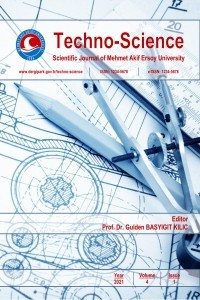Production of biogas as an energy source in colder area, using flat plate thermal collector
Production of biogas as an energy source in colder area, using flat plate thermal collector
Biogas, thermal collector, slurry, digester renewable energy, cow dung, food waste, bio mass,
___
- [1]. Chen, X., Romano, R. T., & Zhang, R. (2010). Anaerobic digestion of food wastes for biogas production. International Journal of Agricultural and Biological Engineering, vol.3 no.4, p. 61-72.
- [2]. Jabeen, M., Yousaf, S., Haider, M. R. & Malik, R. N. (2015). High-solids anaerobic co-digestion of food waste and rice husk at different organic loading rates. International Bio deterioration & Biodegradation, vol. 102, p.149-153
- [3]. PEPA (Pakistan Environmental Protection Agency), 2005. Guideline for Solid Waste Management. Pakistan Environmental Protection Agency, Islamabad, Pakistan
- [4]. Cheng, H., & Hu, (2010). Municipal solid waste (MSW) as a renewable source of energy: Current and future practices in China. Bio resource technology, vol.101 p.113816-3824.
- [5]. Liu, X., GAO, X., Wang, W., Zheng, L., Zhou, Y., & Sun, (2012). YPilot-scale anaerobic co-digestion of municipal biomass waste: Focusing on biogas production and GHG reduction. Renewable energy, vol. 44 p.463-468
- [6]. Solomon, S., Qin, D., Manning, M., Averyt, K., & Marquis, M. (Eds.). (2007). Climate change 2007-the physical science basis: Working group I contribution to the fourth assessment report of the IPCC (Vol. 4). Cambridge university press.
- [7]. Karthikeyan, O. P., & Visvanathan, C. (2012). Effect of C/N ratio and ammonia-N accumulation in a pilot-scale thermophilic dry anaerobic digester. Bioresource Technology, vol. P. 113, 294-302.
- [8]. Da Silva, E. J. (2010). Biogas Generation: Developments, Problems and Tasks (An Overview). Page this volume
- [9]. Ren, Z., Chen, Z., Hou, L. A., Wang, W., Xiong, K., Xiao, X., & Zhang, W. (2012). Design investigation of a solar energy heating system for anaerobic sewage treatment. Energy Procedia, vol. 14, p. 255-259.
- [10]. Nirunsin, R., Setthapun, W., Dussadee, N., & Ninsonti, H. (2017). Enhancement of household biogas production by solar collector and solar greenhouse. Journal of Renewable Energy and Smart Grid Technology, vol.12 no.1, p. 103-116.
- [11]. Yuan, S., Rui, T., & Hong, Y. X. (2011). Research and analysis of solar heating biogas fermentation system. Procedia Environmental Sciences, vol.11, p. 1386-1391.
- [12]. Uzodinma, E. O. U., Ofoefule, A. U., Eze, J. I., & Onwuka, N. D (2007). Optimum mesophilic temperature of biogas production from blends of agro-based wastes. Trends in Applied Sciences Research, vol. 2 no.1. P.39-44
- [13]. Dioha, I. J., Eboatu, A. N., Sambo, A. S., & Birnin, K. A. M. (2006). Investigation of the effect of temperature on biogas production from poultry droppings and Neem tree leaves. Nig. J. Solar Energy, vol 16, p. 19-24.
- [14]. James, L. W., Charles, C. R., Mirhd, S. S., & Smith, S. R. (1998). Handbook on biogas utilization. Georgia institute of Technology, Georgia.
- Yayın Aralığı: Yılda 2 Sayı
- Başlangıç: 2018
- Yayıncı: Burdur Mehmet Akif Ersoy Üniversitesi
Fabrication of microinjector system (SIM) using anodic aluminum oxide
Rehana NAZİR, Ajab Khan KASİ, Jafar Khan KASİ
Production of biogas as an energy source in colder area, using flat plate thermal collector
Naqeeb Ullah KAKAR, Jafar Khan KASİ, Ajab Khan KASİ, Samiullah TAREEN
